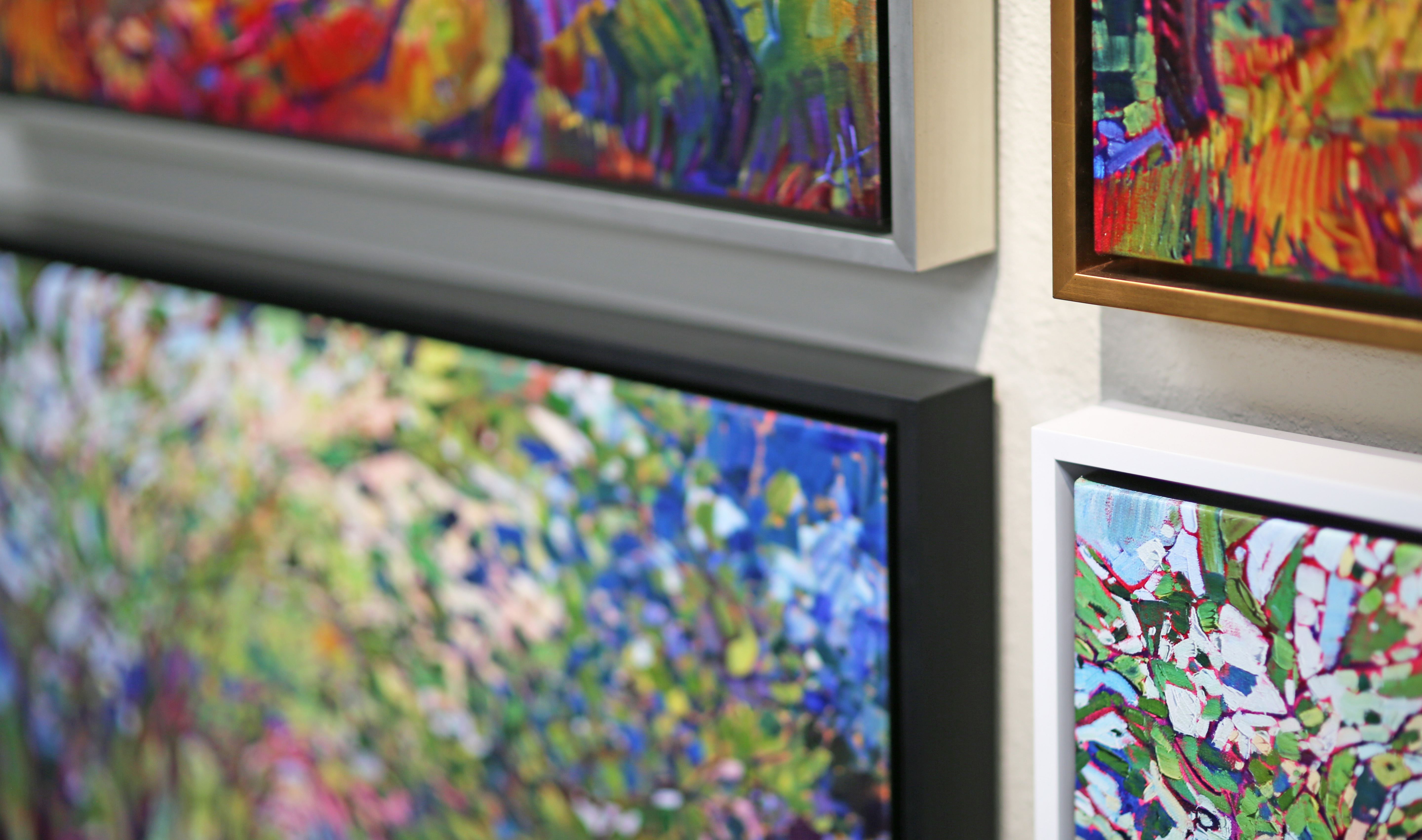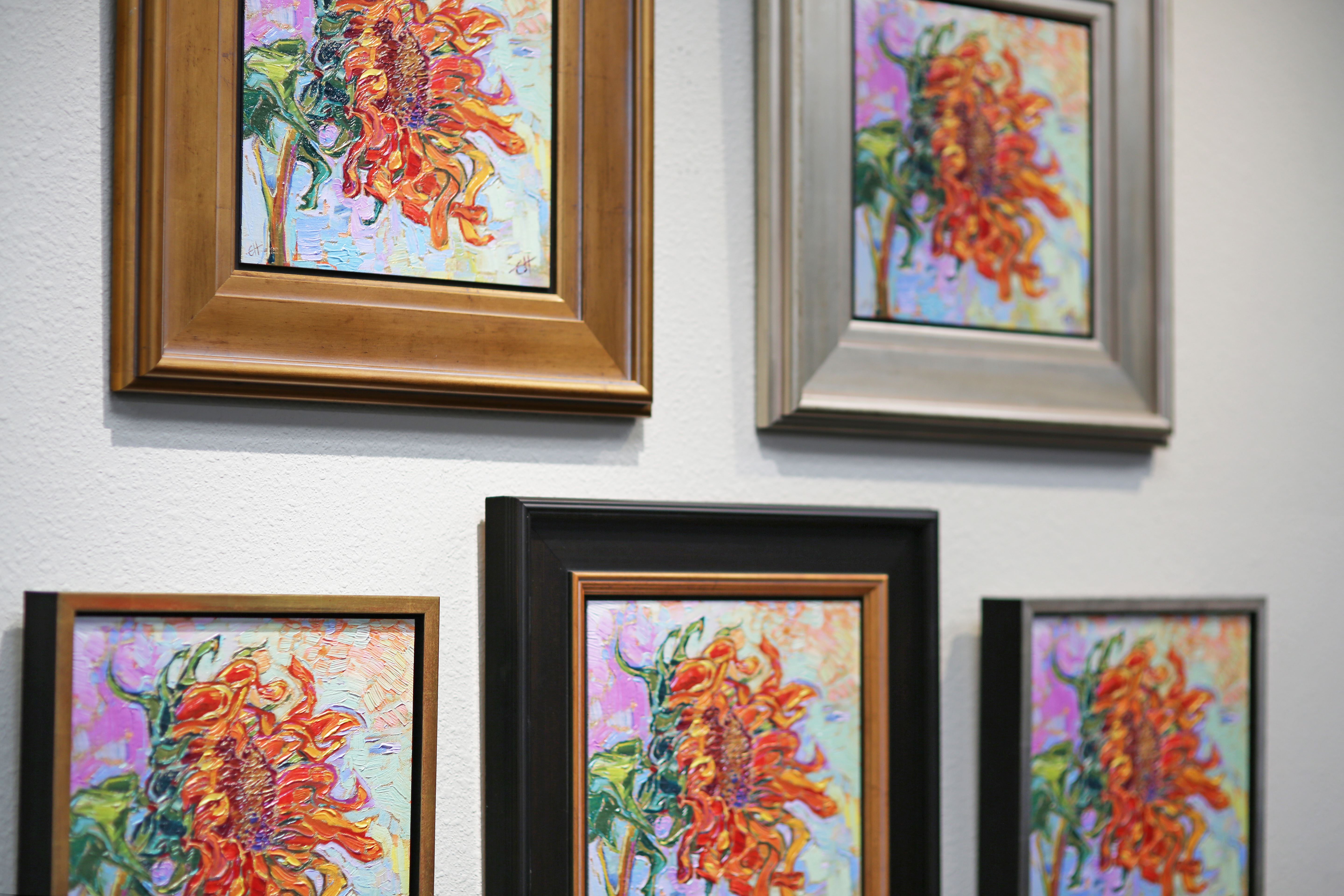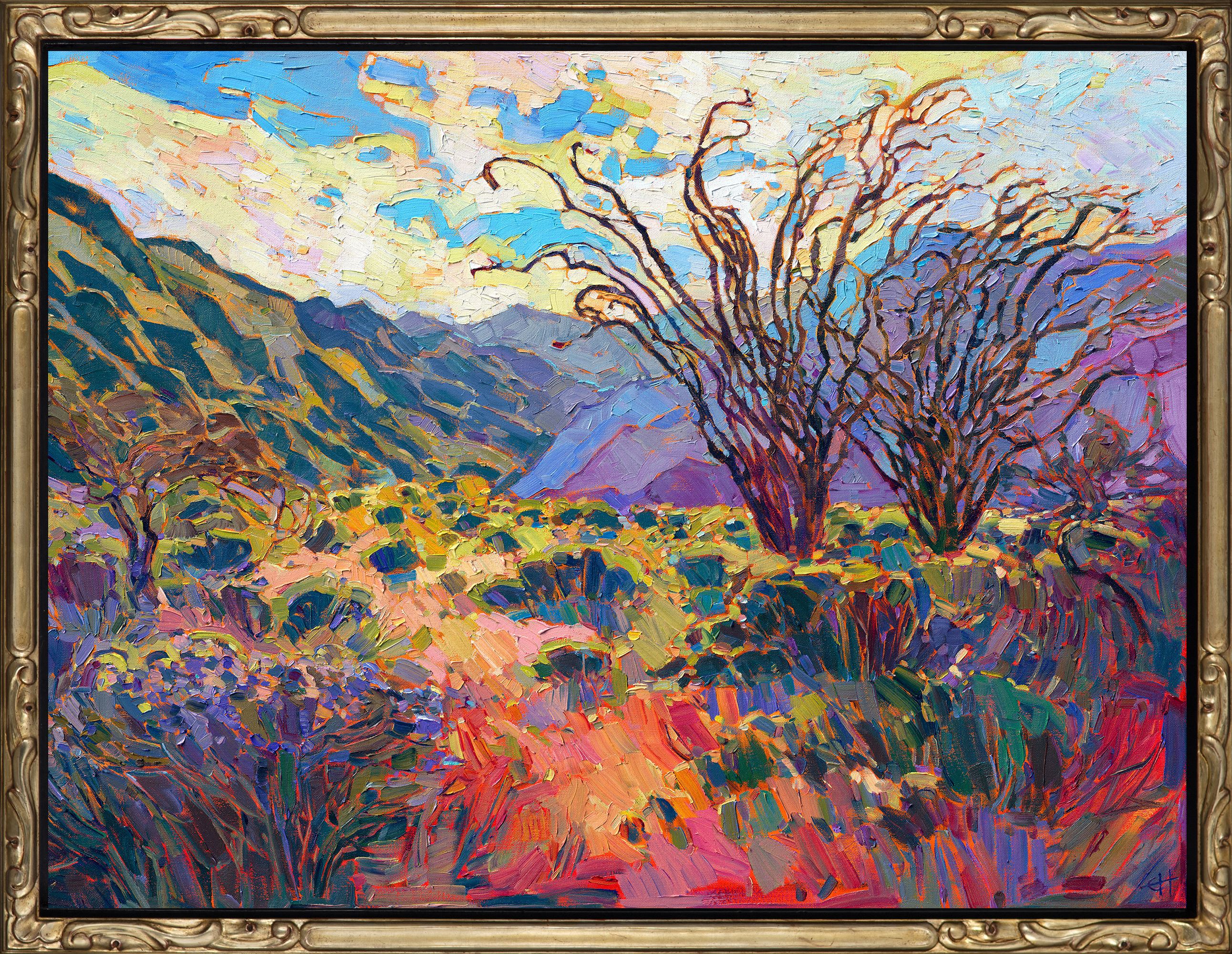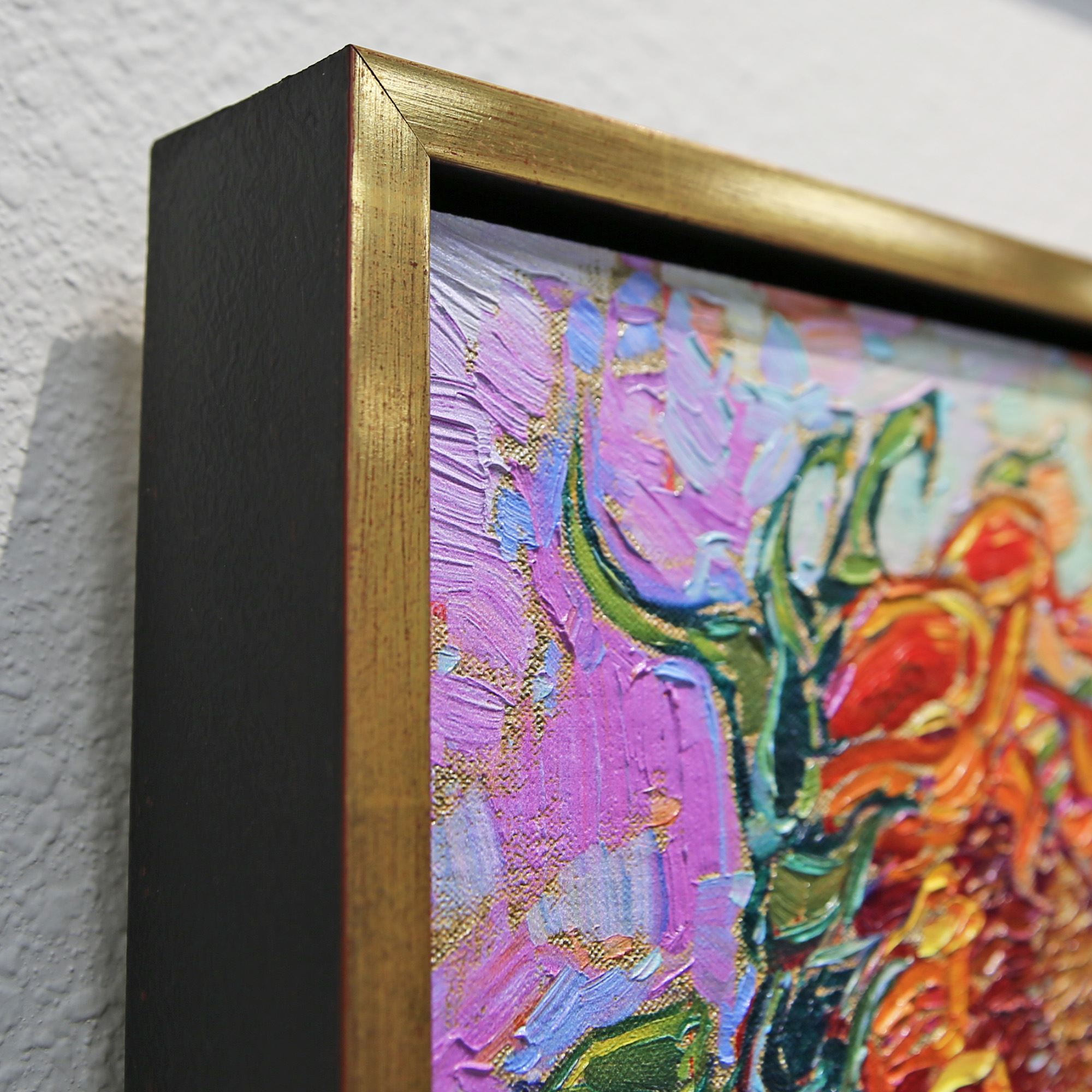Subtotal
$0
U.S. Shipping
FREE
Saved for Later
Shopping Cart
Subtotal
$0
U.S. Shipping
FREE
Saved for Later
One question that gets asked here at the Erin Hanson Gallery is "What is a floater frame?" or "What is a floating frame?"
We are here to answer that question -- and give you an overview of the various framing styles we use when framing Erin Hanson's oil paintings, canvas prints, and 3D Textured Replicas here at the gallery.
What are floater frames?
Floater frames are a type of frame that leaves space between the artwork and the frame itself. In this way, the painting or print is "floating," allowing the viewer to see the complete piece without any part of the painting being interrupted or concealed.
Instead of a frame lip covering the front of the painting, which can damage an oil painting and interrupt the flowing motion of a brush stroke, the frame lip wraps the back of the piece, holding the art in place and giving the collector an unobstructed view. This framing method is even more effective when the work is original. Hanson paints all the way to the edge of the canvas, so this frame allows you to see the entire piece, even as it wraps around.
At The Erin Hanson Gallery, all floater frames have standardized dimensions to ensure collectors can measure their walls and guarantee a great fit before purchasing a canvas print or original painting.
Here is an idea of the specs for an Erin Hanson floater frame:

Beautiful silver, gold, black, and white floater frames showcasing Erin Hanson's Crystal Light Collection.
Should I use a floater frame?
While a collector can frame Erin Hanson's original or canvas print in any frame they desire, Hanson chooses to present and sell her pieces in a floater frame for the following five reasons:
1. The floating frame allows the viewer to enjoy the entire piece. Erin Hanson intends for viewers to see her complete work, which means being able to enjoy the painting to the very edge of the canvas. When an art aficionado can enjoy the entire work as the artist intends, they can see and experience the piece's motion, emotion, and beauty.
2. Our in-house team has searched high and low for the perfect framing materials. We make floater frames in-house, and every frame is custom-built to house each work snugly.
3. The Erin Hanson Gallery team makes every frame to Erin's specifications. She regularly inspects the final products for quality and ensures that the framing corresponds with the piece before shipment.
4. A floating frame is magical. It really appears as if the painting is floating within the frame. That optical illusion adds more depth to every image.
5. The frame won't damage the work. Unfortunately, traditional frames press against an oil painting. Oil paints oxidize over time, which means that while oil paints harden, they never wholly "dry" in the traditional sense. So, when something is pressed against an oil painting, it is more likely to sustain damage. Also, the gilding from the frame often sticks to the surface of the painting.
Another factor to consider is that covering one area of an oil painting and exposing another changes the oxidation rate, which will cause the uncovered portion to look different from the covered portion over time.
When a painting is placed in a frame that does not cover any portion of the image, it allows the oil to oxidize evenly, allowing it to age gracefully.
Other Erin Hanson Frames
At The Erin Hanson Gallery, we build several kinds of frames, including specialized frames with their own shine and luster. Read on to find out more about the other Erin Hanson frames:
What are "mock" floater frames?
"Mock" floater frames are what they sound like - frames intended to look like a floater frame - but function like a standard frame or plein air frame. We use mock floater frames to frame 3D Textured Replicas, which are printed on dibond, and Erin Hanson's petite paintings, which are painted on linen board.
The "mock" floaters are beautiful frames with a thin line of black that wraps around the piece. This slim line makes it appear as if the area around the work is empty, providing the same depth that a floating frame imparts. Because many collectors enjoy purchasing originals, canvas prints, 3D Textured Replicas, and petites, the mock floating frame allows them to showcase their work with a consistent framing option. These are made by using archival artisan glue to affix the dibond or linen panel to a piece of hardboard that has been painted black. The hardboard is then placed in the frame, which protects the artwork and keeps it from touching the frame.

Gold, silver, and black mock floater frames showcasing Erin Hanson's "Sunflower Bloom" piece.
What is an "Open Impressionism" frame?
We have written about "Open Impressionism" frames in previous posts. However, here is a brief description.
Several years ago, Hanson designed a frame type that both complemented her style and paid homage to the long history of impressionism from which she was inspired.
To understand Erin Hanson's design choices, we must go back in time to cover a little impressionist history.
In the 18th century, Impressionists rebelled against the large, gilded frames that wrapped around most artworks at that time. Instead, they chose thinner, less imposing frames. However, dealers at the time wanted to sell the art, so they decided to showcase the works in more familiar Louis XIV and XV-style frames to give the art gravity. This choice continues today in museums around the world.
Inspired by this style and the history of the "impressionist frame," Hanson wanted to give her paintings a more contemporary framing option. So, she developed the "Open Ompressionist frame." This frame pays homage to the lovely curves of the original "impressionist frame" while toning down the detailing and providing a more contemporary feel. It is a floater frame produced with hand-carved hardwood molding. Delicate patterns are custom-designed to compliment the curving brushstrokes and wide open spaces found in an Open Impressionist painting.
These handmade frames have closed corners, meaning the framer used plaster to fill in the joining cracks, then applied the priming clay and gilding on top. The frames are finished in 23kt gold leaf using the "water gilding process," described below. Depending on the color of the clay and the amount of silver included in the gold leaf, we can create frames that range in color from soft, champagne gold to rich, reddish gold.

What is an Erin Hanson Gold Leaf Floater Frame?
Erin Hanson offers a beautiful, 23kt gold leaf floater frame for her original oil paintings and Limited Edition 3D Textured Replicas. She calls this frame the "Gold EH Frame."
This is another frame made at The Erin Hanson Gallery, created with the highest quality gold leaf.
Here's an explanation of what that means and why it's a beautiful compliment to Hanson's work.
Gold leaf comes in many different weights and types. In fact, some gold leaf that you see applied to interiors is not gold at all - just an amalgam of copper, zinc, and brass called "metal leaf" that has the appearance of gold. Think fool's gold for interior decoration.

The EH Gold Leaf Floater Frame has genuine 23kt gold leaf of the highest quality applied with water gilding. This process makes the wooden frame look like gold. Here is a brief description of how this is done:
This unique frame adds even more beauty and depth to the painting as the shine of authentic gold accents the painting's colors.
While you can see many frame details here in this article, we hope you will continue your exploration of Erin Hanson's artwork and framing choices by enjoying her portfolio of originals and prints.
Discover the artist at the forefront of modern impressionism.

About Erin
ERIN HANSON has been painting in oils since she was 8 years old. As a teenager, she apprenticed at a mural studio where she worked on 40-foot-long paintings while selling art commissions on the side. After being told it was too hard to make a living as an artist, she got her degree in Bioengineering from UC Berkeley. Afterward, Erin became a rock climber at Red Rock Canyon, Nevada. Inspired by the colorful scenery she was climbing, she decided to return to her love of painting and create one new painting every week.
She has stuck to that decision, becoming one of the most prolific artists in history, with over 3,000 oil paintings sold to eager collectors. Erin Hanson’s style is known as "Open Impressionism" and is taught in art schools worldwide. With millions of followers, Hanson has become an iconic, driving force in the rebirth of impressionism, inspiring thousands of other artists to pick up the brush.